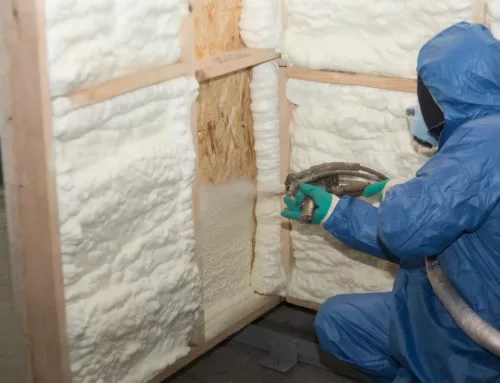Getting spray foam insulation on your hands can be a sticky situation, but knowing how to remove spray foam from hands is essential for any DIY enthusiast or professional. This piece will walk you through the best ways to tackle both wet and dry foam without causing damage to your skin. From immediate actions like rinsing with warm soapy water to employing household remedies such as baking soda and oil, we’ve got you covered.
You’ll also discover how softening agents can make removal easier and when mechanical methods might come into play. Plus, learn about the safety precautions that are crucial when handling these materials. So roll up your sleeves—let’s dive into safely stripping away unwanted foam and maintaining healthy skin afterward.
Immediate Actions to Prevent Spray Foam Adhesion
If spray foam gets on your hands, think fast and act faster. You want to stop that sticky mess from turning into a solid headache. So, let’s talk turkey about how you can keep your hands clean when working with spray foam.
Rinse with Warm Soapy Water
First off, if the spray foam hasn’t cured yet—you’re in luck. Grab some warm soapy water and start rinsing those hands like there’s no tomorrow. The warmth of the water helps break down the foam while soap acts like a bouncer at a club—kicking out unwanted guests on your skin.
This isn’t just good advice; it’s science in action because uncured polyurethane spray foam is still playing nice and will usually wash away without too much fuss.
Using Running Water for Initial Cleaning
You’ve got running water? Perfect. Put it to work. Keep those hands under the tap and let the constant flow send that stubborn spray packing before it settles in for a long stay on your skin. Think of it as giving your hands a mini power-wash session right at home.
And remember, time is ticking—the longer you wait, the harder removal becomes once that gunk cures up tighter than Fort Knox.
Strategies for Removing Cured Spray Foam from Hands
If you’ve had a run-in with polyurethane spray foam, you know it’s like the Hulk of adhesives: strong and stubborn. Once this stuff cures on your skin, it might seem like it plans to stick around longer than that one relative after Thanksgiving dinner.
Softening Agents for Easier Removal
The first thing to understand is curing means liquid foam has transformed into a solid state—this can happen quicker than ice cream melting on a hot sidewalk. And if not tackled promptly, we’re talking about potential skin irritation or even auditioning as a statue in the local park.
Luckily, products like petroleum jelly and isopropyl alcohol are great at convincing cured spray foam to take a hike without turning your hands into sandpaper. Apply some petroleum jelly generously over the affected area; think of slathering up butter on toast but way more liberally. Let it sit there doing its magic before gently rubbing off what was once an immovable object.
In cases where hardened insulation materials act too high and mighty for mere jellies, bring out the big guns with acetone-based nail polish removers. Just dab some onto those pesky spots and watch the dried spray foam start to dissolve.
Mechanical Methods to Remove Spray Foam From Hands
Sometimes chemical warfare isn’t enough against these resilient foams. When chemistry fails us, physical persuasion steps up to bat—that’s right; we’re looking at scraping away residue using tools like nail files. Remember though; be gentle. Your aim here isn’t carpentry work but rather mimicking an archaeologist uncovering relics—with less dust hopefully.
Once you’ve liberated your skin from its foamy cage by any combination of softening agents and elbow grease methods mentioned above, don’t forget to wash thoroughly with warm soapy water afterward because nobody wants their hands smelling like they just left Chemistry 101 class.
Key Takeaway:
Do stubborn spray foam on your hands? No worries. Slather on petroleum jelly or use isopropyl alcohol for a gentle send-off. For tougher cases, acetone-based nail polish remover does the trick—just keep it away from flames. If all else fails, gently scrape with pumice stones or emery boards and wash up after.
Home Remedies for Spray Foam Removal
Baking Soda and Oil Method
Don’t panic. You can turn to your kitchen cabinet for a solution. Mixing baking soda with some kind of oil, like olive or coconut, creates a gritty paste that’s perfect for tackling the stickiness of cured polyurethane foams. Apply this homemade concoction generously over the affected area and rub gently—the mild abrasive nature of baking soda paired with the lubricating effect of oil helps lift those pesky dried foam bits right off.
This method is especially handy when you’re dealing with nail polish remover-resistant spots. Baby powder sprinkled on afterward can absorb any oily residue, leaving your skin as smooth as ever. And if you need an extra dose of care post-removal, don’t forget to slather on some hand lotion; it’ll soothe any irritation caused by the drying effects of insulation materials.
If you’ve found yourself in a sticky situation after insulating your home, remember these simple at-home tricks that can save the day (and your skin).
Safety Precautions When Handling Insulation Materials
Working with insulation, especially spray foam, is no joke. Spray foam toxic mishaps can turn a regular day into an itchy nightmare if you’re not careful. Before getting down to business, make sure you suit up like a pro—rubber gloves are your first line of defense.
Think of rubber gloves as the knight’s armor in the battle against stubborn spray foam sticking to your skin. And don’t just grab any pair; use thick rubber gloves that’ll withstand the stickiest of situations. Remember, when dealing with chemicals and expanding foams, double protection never hurts—so layering a disposable plastic glove underneath could save you from some sticky predicaments.
But hey, even the bravest knights get caught off guard sometimes. If that pesky foam breaches your defenses and gets on your skin—even after wearing gloves—you’ve got to act fast. Immediate washing with warm soapy water might just be what saves the day before that stuff cures harder than concrete on a hot summer’s sidewalk in Kansas City.
Maintenance Tips After Removing Spray Foam
Got that sticky spray foam off your hands? Great job. But don’t throw in the towel just yet. Your skin’s been through a lot, and it deserves some TLC. Think of it like this: You’ve just battled the sticky beast and won—now it’s time to heal from the skirmish.
Caring for Your Skin Post-Foam Warfare
The battle against cured spray foam can leave your skin drier than in Kansas during a heatwave. So let’s start with rehydration. Grab some hand lotion or moisturizer—and I’m not talking about that watered-down stuff you find at hotels; get something with muscle. Slather on a generous amount right after cleaning up because if you think polyurethane is tough on walls, imagine what it does to your skin.
Next up, monitor any signs of irritation like redness or itchiness closely—these could be distress signals from your epidermis saying “Hey buddy, I need more help.” If these symptoms stick around longer than unwanted relatives during holidays, consider seeing a professional.
Spot Checks Are Your Friend
You wouldn’t drive without checking blind spots, so why would you skip out on spot checks for lingering foam? Sometimes tiny beads of evil linger even after washing with warm water and soap—a real eye-sore if left unattended. Pat down those paws with paper towels to make sure every last bit has hit the road.
If there are stubborn spots where dried foam clings like static socks fresh outta the dryer, rub gently but firmly using oil or nail polish remover (only as a last resort though—it’s strong stuff.). Remember: Be kind to yourself; harsh rubbing isn’t going to win any medals here.
Key Takeaway:
After the foam fight, pamper your skin with a heavy-duty moisturizer. Keep an eye out for irritation signs and do spot checks to ensure all foam is gone. For future projects, wear disposable gloves to avoid another sticky situation.
The Benefits of Kansas Spray Foam Insulation
When you’re living in a place like Kansas, where the weather can swing from tornado warnings to serene sunny days, having insulation that keeps up is crucial. That’s where Kansas Spray Foam Insulation comes into play. It’s not just about staying cozy; it’s about creating an energy-efficient environment for homes and businesses alike.
Spray foam is like a superhero for your walls—it swoops in, expands, and forms an impenetrable barrier against air leaks. In business terms? Less draft means lower utility bills. You see, this stuff seals nooks and crannies tighter than a Tupperware lid—keeping conditioned air exactly where you want it: indoors.
Kansas folks understand the value of hard work—and so does their choice in insulation. Unlike traditional materials that may sag or settle over time, spray foam holds its ground without batting an eye (or budging an inch). And let’s talk safety because nothing dampens spirits quite like indoor pollutants or moisture issues which can lead to mold growth. Thankfully, our trusty spray foam doesn’t give those troubles room to breathe by creating a solid defense against both.
This powerhouse isn’t only about protecting structures but also people who inhabit them every day by offering safe havens free from outdoor allergens sneaking inside—a plus for anyone tired of battling hay fever during harvest season.
So while we might love our unpredictable weather here in the Sunflower State—from twisters to tranquility—Kansas Spray Foam Inspiration ensures whatever happens outside stays outside, keeping everyone inside comfortable and content all year round.
Conclusion
So, you’ve tackled the sticky challenge of how to remove spray foam insulation from your hands. Remember, quick action with warm soapy water can save your skin from stubborn foam. And if it’s already cured? Softening agents and household remedies are your go-to for gentle removal.
Keep in mind: physical methods like scraping should be a last resort. Chemical removers work wonders but handle them with care. Always protect yourself; wearing gloves is non-negotiable when dealing with expanding foams.
Maintain vigilance post-removal—moisturize and watch for irritation signs. And let’s not forget, that prevention beats cure every time. Arm yourself with knowledge and tools to keep those hands clean and clear next time around.
Read More:




